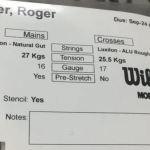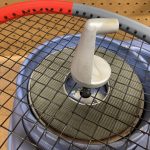Answering Your Questions About String
Back in the day when someone wanted a racquet restrung there were just not that many options. The vast majority of racquets were made of wood, had very small head sizes (85 sq in) and the same stringing pattern (18×20). However, in today’s world all of that has changed, including strings. Questions abound when it comes to this subject so let’s take a look and see if we can’t answer some of them
Q: What’s the most common material for racquet string?
A: Nylon is still the king and the most common material in today’s recreational market. However, as the technology has advanced, so too has string construction.
Q: What is “synthetic gut”?
A: Strings are made from extrusions of various filaments. Typically “synthetic gut” is the term applied to any string that has more than one filament.
Q: What is the most popular string gauge, or diameter?
A: 16 gauge, (1.30mm-1.32mm) is still the most common gauge used in the recreational market today.
Q: What is a “hybrid”?

A: We see more and more players on the tour using hybrid stringing. A hybrid is a combination of two (2) different strings in the same racquet. It can be as simple as two different colors or two different gauges of the same string. In today’s game we’re seeing more variations thanks to the touring professionals. Many have followed Federer’s lead and are using a hybrid of two (2) different string materials. In Federer’s case, it’s natural gut in the main strings and a textured polyester string (Luxilon ALU Rough) in the cross strings. The only way you’re going to know if a hybrid like Federer’s is going to work for you is to have it done in your racquet and take it out for a test drive. If you click on the image to enlarge it you can also see that he uses different reference tensions on the mains and crosses plus, he prefers the natural gut to be pre-stretched but not the polyester.
Q: How long will string last in a sealed package?
A: If the package is stored properly, meaning not in direct sunlight or exposed to extreme temperatures it should be good for at least one year.
Q: How long will string last in a racquet?
A: What you’re really asking here is how long should I expect to get maximum performance from my strings. This is like asking how long a set of tires will last on your car. Everyone is different so consider the following. How many times do you play each week and of those times, how many hours are you on the court? Do you use excessive spin, topspin or slice? What is the stringing pattern of your racquet? How do you care for your racquet when not in use? Is it subjected to extreme heat as in being stored in your car’s trunk/boot in August where temperatures are extreme? All of these factors and others can affect string life.
Q: When should I re-string my racquet?
A: In reality the majority of nylon based strings lose enough tension in 30 to 35 hours that you should consider restringing for maximum performance. The performance of other strings vary because materials like natural gut and Zyex based strings have better tension maintenance while many polyester strings lose tension very quickly. Again, this is more complicated than it may appear on the surface. A good stringer will keep records so they know exactly when your racquet was strung and at what reference tension. This is referred to as a baseline measurement. The racquet’s tension is measured immediately after it comes off of the stringing machine and then checked periodically after that. If you feel a downgrade in performance you should take your racquet back, have the tension measured again and then compare it to the baseline measurement to see how much tension was actually lost. Once you dial in these data you’ll get a better understanding of when to re-string.
Q: How do I know what the tension in my string is?

A: There are a few devices out there today that can give you this information. An important factor to remember is that the reference tension set on the stringing machine is not going to match up to whatever the reading is on the device used to test the actual string tension, referred to in the industry as SBS (string bed stiffness). One of the more reliable devices to check SBS is a Babolat RDC (racquet diagnostic center). A plunger is centered on the string bed and the device is activated, producing a numeric readout.
Q: Should I pre-stretch string?
A: At IART we are big proponents of pre-stretching string because it would be nearly impossible for a person to manually pull the string hard enough to damage it. Some stringing machines have pre-stretching capabilities but manually pre-stretching by hand in a single long piece is very effective. Pre-stretching will stabilize the string, make it a little easier to handle during the installation process and reduce initial tension loss in the racquet. As a side note, the vast majority of recreational players have no idea of what pre-stretching string is. That’s something that a trained technician would be aware of and use at their own discretion, with the exception of tournament stringing where it’s not uncommon for the players to request it.
The reality in today’s market is that there are literally hundreds of strings available and it can be a real challenge to figure out what string and tension are best for your personal game. We recommend you seek out and use a highly trained racquet technician who can guide you through the process. IART has a directory HERE that lists members and their locations. Entering your state in the search bar is the fastest way to see if there’s a trained technician close to you.


Leave a Reply
You must be logged in to post a comment.